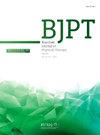Pelvic floor muscle training for urinary symptoms, vaginal prolapse, sexual function, pelvic floor muscle strength, and quality of life after hysterectomy: a systematic review with meta-analyses
IF 3.2
3区 医学
Q1 ORTHOPEDICS
引用次数: 0
Abstract
Background
After hysterectomy, women could experience pelvic floor dysfunction and negative impact on quality of life, which could be improved by pelvic floor muscle training.
Objective
To investigate effects of pelvic floor muscle training on urinary symptoms, vaginal prolapse, sexual function, pelvic floor muscle strength, and quality of life after hysterectomy.
Methods
Systematic review with meta-analyses of randomized controlled trials. Trials with pelvic floor muscle training in women after hysterectomy were included. The outcomes measures were urinary symptoms, vaginal prolapse, sexual function, pelvic floor muscle strength, and quality of life. Quality of evidence was assessed by adopting the GRADE approach.
Results
Six trials, involving 776 participants, were included. The mean PEDro score of trials was 5.5. Moderate-quality evidence suggested that pelvic floor muscle training improves sexual function by 5 points (95% CI: 4, 6) on the Female Sexual Function Index, compared with no intervention. It might affect strength (SMD 0.5; 95% CI: −0.4, 1.3), quality of life (SMD 0.5 points out of 108, 95% CI: −0.1, 0.9), urinary symptoms (RD −0.02; 95% CI: −0.06, 0.1); however, the estimates were too imprecise. In addition, it produces no or negligible effects on vaginal prolapse (RD 0; 95% CI: −0.1, 0.1). Long-term effects remain uncertain.
Conclusion
This systematic review provides moderate-quality evidence that pelvic floor muscle training is effective for improving women's sexual function after hysterectomy, in comparison with no intervention. Benefits on urinary symptoms, pelvic floor muscle strength, quality of life, and vaginal prolapse remains unclear. Also, the effects beyond the intervention period remains uncertain.
针对子宫切除术后泌尿系统症状、阴道脱垂、性功能、盆底肌肉力量和生活质量的盆底肌肉训练:荟萃分析系统综述。
背景:子宫切除术后,妇女可能会出现盆底功能障碍,并对生活质量产生负面影响:子宫切除术后,妇女可能会出现盆底功能障碍,并对生活质量产生负面影响,而盆底肌肉训练可以改善这些问题:研究盆底肌肉训练对子宫切除术后排尿症状、阴道脱垂、性功能、盆底肌肉力量和生活质量的影响:方法:对随机对照试验进行系统回顾和荟萃分析。方法:对随机对照试验进行系统回顾和荟萃分析,纳入对子宫切除术后妇女进行盆底肌肉训练的试验。结果测量指标包括泌尿系统症状、阴道脱垂、性功能、盆底肌肉力量和生活质量。采用 GRADE 方法对证据质量进行了评估:结果:共纳入六项试验,涉及 776 名参与者。试验的平均 PEDro 得分为 5.5 分。中度质量的证据表明,与不采取干预措施相比,盆底肌肉训练可在女性性功能指数(Female Sexual Function Index)上将性功能提高 5 分(95% CI:4, 6)。它可能会影响力量(SMD 0.5;95% CI:-0.4,1.3)、生活质量(SMD 108 分中的 0.5 分,95% CI:-0.1,0.9)、泌尿系统症状(RD -0.02;95% CI:-0.06,0.1);然而,估计值过于不精确。此外,它对阴道脱垂没有影响或影响微乎其微(RD 0;95% CI:-0.1,0.1)。长期效果仍不确定:本系统综述提供了中等质量的证据,证明盆底肌肉训练可有效改善子宫切除术后妇女的性功能,而不采取任何干预措施。但对泌尿系统症状、盆底肌肉力量、生活质量和阴道脱垂的益处仍不明确。此外,干预期结束后的效果仍不确定。
本文章由计算机程序翻译,如有差异,请以英文原文为准。
求助全文
约1分钟内获得全文
求助全文
来源期刊
CiteScore
6.10
自引率
8.80%
发文量
53
审稿时长
74 days
期刊介绍:
The Brazilian Journal of Physical Therapy (BJPT) is the official publication of the Brazilian Society of Physical Therapy Research and Graduate Studies (ABRAPG-Ft). It publishes original research articles on topics related to the areas of physical therapy and rehabilitation sciences, including clinical, basic or applied studies on the assessment, prevention, and treatment of movement disorders.

 求助内容:
求助内容: 应助结果提醒方式:
应助结果提醒方式:


